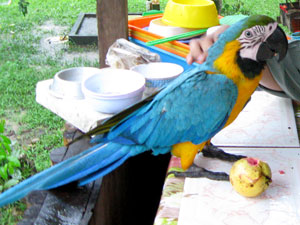Spending time in Peru’s Amazon Rainforest and learning about the ecosystem was incredible, but the second part of our trip was even more amazing. In case you missed it: Project Peru Amazon: Part One.
5 truly enlightening days were spent volunteering (voluntouring) at Amazon Shelter. This is a centre for rehabilitation and conservation of wild animals. Magali is the owner and proprietor of this small centre and has a huge heart when it comes to people and animals. Magali has been rescuing animals for several years now and works to educate the local people.
Amazon Shelter is a non governmental organization (NGO) founded in 2005 by Magali Salinas, an animal lover who decided to fight against the illegal wild animal trade. At the beginning, activities were focused on helping the authorized governmental institutions in the rescue, rehabilitation and relocation of confiscated or abandoned wild animals. “Do not buy animals” is one of our main slogans, because no demand implies no offering of animals.
Experience taught us that our efforts must be oriented to educate people instead of only rescuing animals. This is why environmental education is our main tool to work with, specially to touch children and teenagers feelings because they are the future of our country and they will be the responsible for guarantee the urgent sustainable development.
Our chores and duties
One of the main duties while at the Shelter was cutting and apportioning out various fruits, vegetables and other foods, depending on the various animals dietary requirements. This would take about an hour or more a few times a day, the time depending on how many were helping with this chore.
At the time of our visit, several veterinary students were also staying in the shelter bungalows. The students were gaining practical knowledge about wild animal care. This helps them choose their specialty, whether they chose wild animals or domestic. As a bonus for the shelter, they shared in the day-to-day chores.
Mark and I did several projects that helped to make various enclosures either bigger or better for the animals. This was not all, while the students were teaching us about the animal care, we were able to teach them simple building skills. Power came from a generator, running for about 3 hours in the evening and you would go without during the day. As an experienced renovator it was difficult to work without power tools, something we westerners take for granted. Screws and nails, often a bit bent or rusty, but were still usable were part of our building materials. It was common to repurpose wood and other materials on the property.
One of my daily chores was taking Tatiana, the young Giant Anteater around the property and finding her termites or ants. She had lost her mother at a young age and it was difficult for her to get proper nutrition.
We would stop at different places on the property and I would point to show her where to dig. She would either dig or reject this spot and I would have to note where and what kind of insect she liked or disliked. There seemed to be no lack of these insects nearby and there are several species on the property.
Giant Anteaters have strong front legs and huge claws that they use to defend themselves. For safeties sake when I needed her to turn around I would pick her up from behind, staying away from this area.

Parrots at a local and poor zoo, enjoy a ladder the students and Terry (your eco friend) built for them
One of our days was spent doing enrichment at a poor local zoo. This included adding vegetation for the turtles and improving the parrots enclosure, giving them perches and a ladder. We used whatever scrap building materials the local proprietor offered. In these areas of the world, you don’t have a local Lowes or Home Depot to visit. You use what you have.
Wild animals and rainforest products
Two experienced wild animal veterinarians Yohanna and Paloma, were visiting for an extended period helping Magali with the animals care and nutritional requirements.
They were great educators and their messages helped us understand how horrible the wild animal trade is to these and other wild animals.
Animals often come to the shelter when people are tired of the work involved in caring for the animals or poachers kill a parent. Many times animals are shipped out of the country illegally in tiny cages or containers where most end up dying.
A perfect example is with baby monkeys. Hunters will often kill the female and will take or sell the baby as a pet. Unfortunately, the babies require 24 hour care. This means you do absolutely everything with the young animal attached to your head or shoulder. This is not something that 99% of the receivers of these animals are prepared for and they grow tired of work and care involved, often abandoning the animal. Nutrition is also a problem, as the animals don’t get a proper diet. The mortality rate is from 90 to 100%.
The Amazon Shelter does a great service by educating various government agencies and the local people. Education is the key. As the Shelter says: no demand implies no offering of animals. The animals belong in the wild.
Another important message we were given, is that the local people are often taken advantage of when it comes to rainforest products. It is common for them to leave their families for an extended period of time for work, not always getting paid for their efforts.
It is not only the animals that are suffering in these cases. We need to be aware of this and help where ever we can. It is important that you look for fair trade products when buying anything from the rainforests of this world and that you never, ever buy exotic animals from your local pet store.
You can learn about the forest or participate in the volunteer program at Amazon Shelter. We went with the help of G Adventures (formerly Gap). They don’t seem to be offering the program anymore but you can contact the shelter to see if you can volunteer directly or find a similar organization.
Donations are always appreciated and will be put to good use.
You can also donate through:
Rain Tree has links to several organizations working to help the people and the rainforests
Their link is here:http://www.rain-tree.com/









